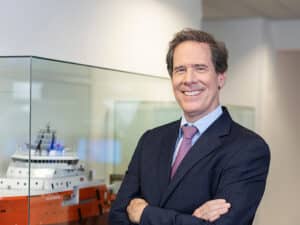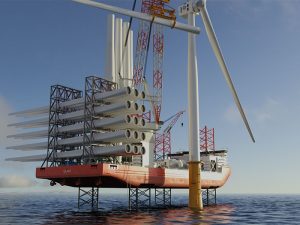
Volvo Penta gears up for U.S. wind farm support vessel sector
Written by Nick Blenkey
NOVEMBER 29, 2017 — As a leading supplier of propulsion systems for support boats in Europe’s booming offshore wind farm industry, Volvo Penta is poised to capture a significant share of the market as new wind farms come into service in North America.
“Wind farm support vessels operate under some of the world’s most difficult conditions,” said Jens Bering, vice president of marine sales for Volvo Penta of the Americas. “They must be able to work 24/7 in high winds and heavy seas delivering crew and materials quickly and safely to the offshore towers without wasting time and fuel. On station, it’s a big challenge for the operator to nose up to the turbine towers and hold position in turbulent waters when transferring technicians and supplies.”
Volvo Penta’s IPS is the ideal solution for these vessels, according to Bering. “When compared to standard shaft drives, IPS consistently produces 30-40 percent longer cruising range, 15-20 percent higher top speed, 20-35 percent reduction in fuel consumption, 20-35 percent less CO2 emissions and 50 percent lower perceived noise levels. In addition, IPS provides safe and predictable boat handling, especially with its standard joystick controls. IPS is also easier to install, taking about 50 percent less time than inboard shafts, and is easier to service. The pods also provide higher torque and faster acceleration, as well as higher bollard pull of approximately four tons per pod unit, so it will not lose grip in high seas.”
Bering cited a study conducted by BMT Nigel Gee in June 2015, comparing propulsion options for a 26 m vessel. IPS scored higher than fixed pitch, controllable pitch, waterjet and linear jet systems, in terms of bollard pull, efficiency, maneuverability and redundancy. The slightly higher initial cost of IPS is more than offset by the dramatic improvement in life-cycle costs.
U.K. based Njord Offshore operates a fleet of 15 crew transfer vessels (CTVs) of 21 m and 26 m. Six of its 26 m CTVs are powered by Volvo Penta IPS900 Quad installations.
“We’ve been using Volvo Penta’s IPS900 Quad system in our 26 m CTVs for over a year now and all expectations have been fulfilled,” said Tom Mehew, director at Njord Offshore, in 2016. “We, and our customers, require speed, maneuverability and efficiency combined with high static bollard push. In addition, we also look for reliability and redundancy to maximize the uptime for our clients. The advantages of the IPS have been fully proven. The joystick controls are intuitive, the control response times are fast and accurate, which ultimately makes docking on a boat landing in rough weather easier and safer – we also have a dynamic fender system to reduce the load on the boat landings during these conditions.”
The U.S. Department of Energy (DOE) predicts rapid growth of offshore wind energy developments in U.S. coastal waters. The first American wind farm at Block Island is now operational, and DOE reports that there are 28 U.S. wind farm projects with a total capacity of over 23,000 megawatts now in the works. Many of them will be further offshore – 30 miles or more.
These projects will require a fleet of specialized support vessels, and Volvo Penta plans to be ready to answer the call, according to Bering.
“We have a strong market share in the European wind farm support vessel segment,” he says. “We have a great deal of real-world experience in this sector and excellent relationships with the naval architects, shipyards and operators, and we are well positioned to meet the demand for these highly specialized vessels as the North American market opens over the next few years.”





Leave a Reply
You must be logged in to post a comment.